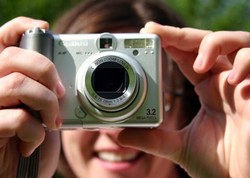

Use our online designer studio to create your own personalised flyers, business cards, greeting cards and more.
Order NowWhen it comes to professional printing and advice on your business marketing, we are the team to call! You can call us direct on 04 568 8773 or fill in our quote form.
Request a Quote
At Copy Express we see a lots of photos used for all kinds of things. Lots of people taking lots of photos of lots of different things. We also see lots of photos that could be so much better if people knew the few simple rules on how to take great photos.
Modern cameras, and most phones, have several different shooting modes. They are for such situations as portraits, landscapes, night, snow, extreme close ups, and so on. Now you might think that the camera’s auto mode will do fine. It will, but only up to a point. When a camera takes a shot, it’s software makes it’s calculations based on a set of rules given to it by the shooting mode. Auto is broadest set of rules, so it is also the easiest to get the shot wrong. By using the right shooting mode you will have a much better chance of getting that great shot because it is using the rules that are just right for that situation.
The most common cause of bad photos is shooting in to the light, which gives you a photo where the background is clear and the subject is dark and dull. The human eye is a marvelous thing and can compensate for staring into bright light so everything has an even brightness, cameras just aren’t that good. If you can, move the subject of the shot so that the strongest light source is behind you (the camera operator) with the light falling on the subject. If you can’t do that see if you can take it where the light falls to the side so the shadows are more natural.
We get photos for print that are too small for use in print. We talk in our artical <about dpi> but the general rule of thumb is it is easier for the printer to throw away pixels it doesn’t need in a image that is too large, than using guesswork to fill in the gaps between the pixels in an image that is too small. Always set your camera to take the biggest photo you can, even if it means you can’t take as many, because if you are following the rules I talk about here then you wont need too.
A lot of photos are taken while the camera is being hand held. Even the most practiced professional can’t keep their camera steady all of the time. Any movement when a shot is being taken will result in a blur and other image problems. Many cameras now have ‘best image’ or ‘burst’ mode, where the camera will take multiple shots with every trigger press and give you the choice to select the best one. This is great as it will allow you to pick the steadiest image so no blur problems.
Lately I’ve seen few shots where someone in the crowd is wearing high visibility clothing or it has reflective strips. High visibility gear will fool the sensor of the camera every time, resulting in the same effect as taking a picture looking directly into a light. If you can, get people to remove the high-vis gear and if not try a snow/beach shot mode as they are designed to deal with large amounts of reflected light.
This is a rule I learnt back in my photographic film days when people use rolls of film. I learnt from the professionals in the industry that for every roll of 24 photos, up to half would be useless, the rest would be okay, and if you were lucky two or three would be great. In this age of digital photos where your shots are instantly viewable, I’ve found that rule to still hold true. When you can delete bad shots to free up space for more, why not take as many as you can to improve your chances to get that great photo you are after.
These rules are just scratching the surface of taking great photos. There are specialised websites dedicated to the subject, for everyone from beginners to seasoned professionals, that go into far more detail that I ever could here in a short blog post. I hope that these few rules will help you take that great shot you need for your next Christmas card, mailer or flyer we print for you. Call Copy Express on 04-568-8773 or email print@copyexpress.co.nz for all your printing needs.